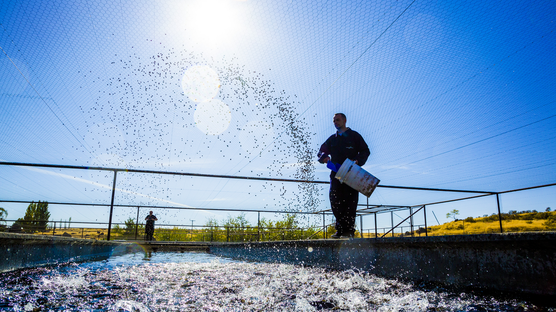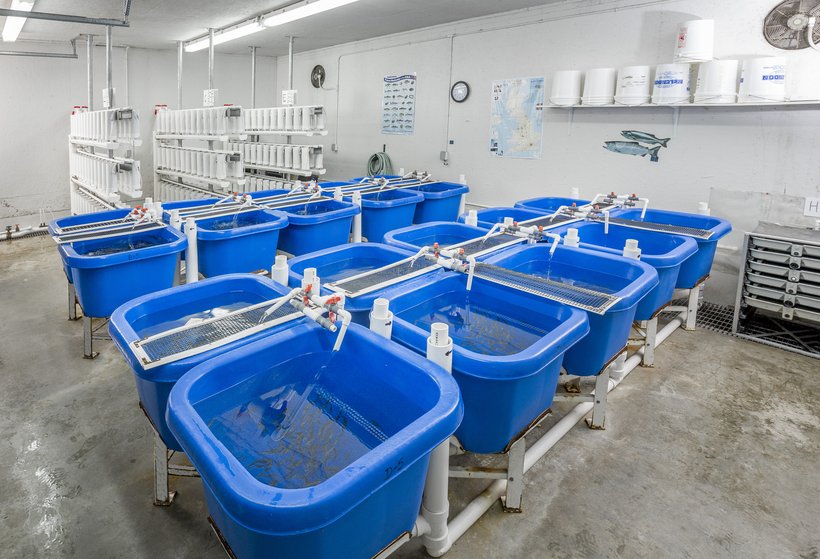
Published on March 18, 2021
Exploring the effects of feed frequency
Feeding regiments can vary widely between trout producers with some using high-tech methods including automated systems and mechanical feeders while others rely on broadcast hand feeding throughout the day. With many options available it can be tough to identify which method or feeding regiment proves to be the most effective.
Troutlodge aims to set the standard in sustainable breeding by conducting industry studies to continuously improve and bring value to our customers. In a recent study, Troutlodge explored the effects of feed frequency for fry, showing the benefits of using Troutlodge stock for maximum production.
This objective of this study was to determine the ideal feeding frequency for juvenile trout in a production setting from first feeding to 25g. For this study, 2000 fish were equally split into 4 tanks and fed 4 different feeding regiments. While the feed rate remained constant, the feed frequency for each group was manipulated. One population was fed using a belt feeder over the course of 8 hours while the remaining groups were hand fed at equal intervals throughout the day (2 times, 4 times, and 6 times a day). Feed rations were calculated based on biomass and distributed evenly among a 5-day schedule and the feed amount was calculated by increasing the recommended feed rates provided by Bio-Oregon by 30%.
Fish were raised indoors at the wet lab in 150-liter tanks. Average daily water temperature during the trial was 9.96⁰C. After 16 weeks, the initial population of 500 animals was divided into 2 separate groups of 200 to maintain a reasonable density in each tank. The first feeding for all groups was at 8:00am and further feedings were broadcast at the intervals shown here.
| Feed Group | Feed Interval |
|---|---|
| Belt Feeder | Continuous |
| 2X | 7.5 hours |
| 4X | 2.5 hours |
| 6X | 1.5 hours |
Feed Conversion Ratio (FCR):
As expected, FCR slowly increased as the trial progressed, and the fish became larger. Although FCR for all feed regimes were similar through the trial, we do see that the fish receiving feed 6X per day and continuously via the belt feeder performed slightly better during the later portion of the trial.
The results show a slight trend toward better FCR as fish were fed smaller amounts more often throughout the day, supporting the conclusion that more frequent feeding is beneficial to feed efficiency.

Thermal Growth Coefficient (TGC):
While TGC is very similar for all groups during the early portion of the trial, during the later half we see a slight indication that more frequent feeding has a positive impact on TGC. As in the FCR data, the abrupt decline in TGC for the final week of the trial can most likely be explained by the 3-day feed week as opposed to 5 days.
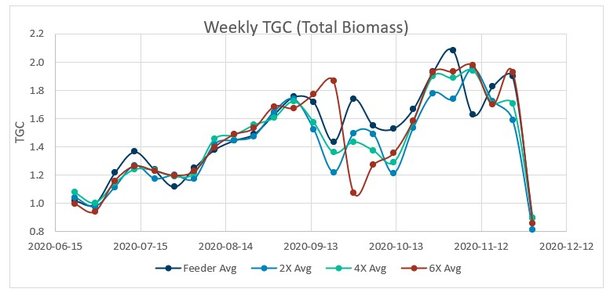
Final Weight/Length/K-factor:
Individual weight and length data was collected on 40 fish from each tank (80 fish per feed frequency group). The data was then tested to determine if there was any significant differences in the weight, length, or K-factor between all of the groups. An F-Test was used to determine if the groups had equal or unequal variance between each population. A T-test was then performed to determine if there was any difference between each group in terms of weight, length, and K-Factor.
Weight: There was no statistically significant difference for the final individual weight data between any of the feed groups. The fish fed using the belt feeder had the largest average final weight (29.45g) and the population mean was significantly different to all other feed groups.
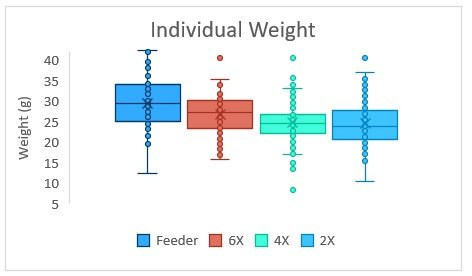
Length: There was no statistically significant difference for the final lengths data between any of the feed groups. Again, the fish fed using the belt feeder had the highest average length (135.25mm) and the population mean was significantly different than all other groups.
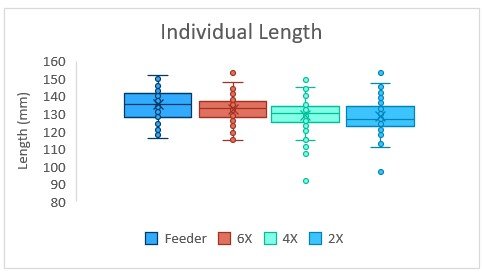
K-Factor:
The variance in K-factor between some feed groups showed significant differences. The K-Factor values for fish being fed using a belt feeder showed a larger variation within the group. This variation was significantly different than the 2X, 4X, and 6X groups. This indicates that while the fish were the larger on average at the end of the trial, they also were the least uniform population.
The data from this study indicates that more frequent feedings may result in a measurable benefit to growers during early rearing of Troutlodge stock. The benefit of more frequent feeding may also come at very low cost to some growers using automated feeding systems. Based on the data collected in this study, the feeding robot used for nucleus fish at the Elm 1 facility will transition from feeding 4 times a day to 6 times a day.
Pairing the superior genetics of Troutlodge with innovative breeding strategies, Troutlodge is the logical choice in sustainable breeding. Our continuous research for innovative solutions translates to faster genetic progress – one of the most important factors in the health of the aquaculture industry today.


